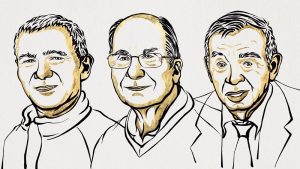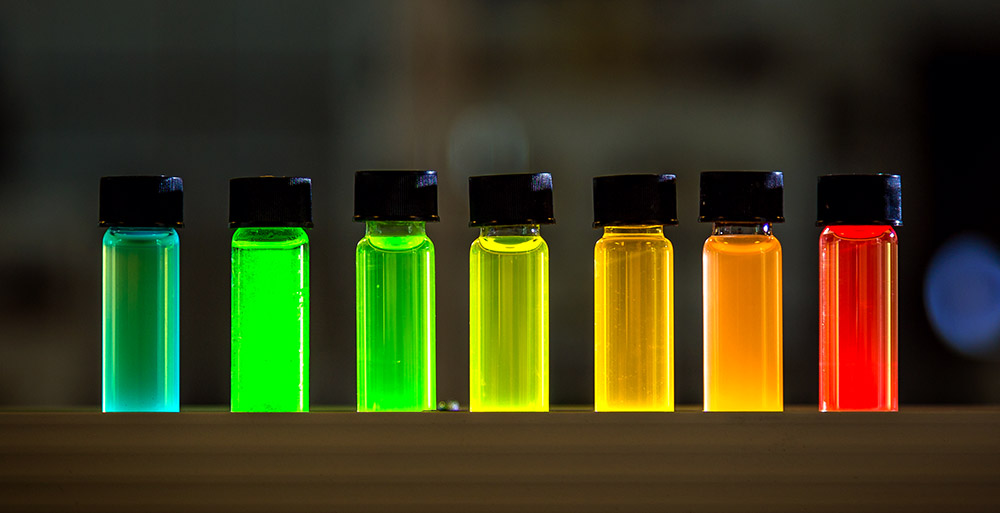October 4, 2023 Reading time: 4 minutes.
The 2023 Nobel Prize in Chemistry goes to three researchers who developed quantum dot technology — nanoparticles found in QLEDs, many televisions and biomedical signs. Alexei Ekimov, Louis Bruce, and Monji Boundy were the first to discover the optical and electronic properties of small nanoparticles in solids or liquids and to develop methods to create these nanodots in a targeted and tailored manner.
They are present in QLEDs and in many televisions and are used as marker materials in medicine: quantum dots are now important assistants in electronics and medicine. Such quantum dots can consist of individual electrons, atoms or “holes” with a positive charge, and can also be created in solids such as semiconductor crystals or in liquids. Crucial to most applications of quantum dots is their ability to emit photons of a specific wavelength when excited by current or radiation.
Custom light
The basic principle behind quantum dots is that there is a band gap in the energy levels of their electrons, similar to semiconductors. The width of this band gap depends on the size of the quantum dots. Quantum dots emit light when recombination of positive electrons and “holes” occurs after charge separation due to excitation. The previously absorbed energy is released in the form of photons – as light of a specific wavelength.
Because the wavelength of this light is specific depending on the quantum dot, the colors of these quantum dots are more intense and sharply defined than, for example, classical LEDs. Other properties of these nanoparticles, such as redox potential in chemical reactions or melting temperature, also depend directly on their size.
The secret of colored glasses
The first prize winner, Alexey Ekimov, of Nanocrystals Technology in New York, took the first step toward discovering quantum dots in 1979 when he was researching colored glasses, then still in the former Soviet Union. His goal was to understand how targeted contamination of such glasses with foreign particles produces their colors and how the growth of these particles in molten glass might be affected more specifically.
Using copper chloride nanocrystals in glass as an example, Ekimov and his team discovered that the spectrum of light absorbed by this glass changes depending on the size of the crystal particles: the smaller the nanocrystals, the more blue the color of the light shifts. Ekimov attributed this effect to the interaction of electrons and holes in the material and created an equation describing the relationship between photon energy and particle size. This marked the discovery of the first semiconductor crystal quantum dots.
The next step was taken in 1983 by a team led by Louis Bruce of Columbia University in New York. Without knowing Ekimov’s discovery, they were searching for colloidal nanoparticles. During experiments with cadmium sulfide particles in solution, they also discovered the effect of particle size on the spectrum of excited particles and prepared a corresponding model. Such size-dependent quantum effects should occur below a particle size of five nanometers, and also affect the photochemical redox potential.

Customized quantum dots
However, the targeted production of such quantum dots was still complex and limited only to certain particles. However, that changed ten years later, in 1993, with the work of the third prize winner, Monje Bondi of the Massachusetts Institute of Technology (MIT). He and his team have developed for the first time a method by which quantum dots of a specific size and high optical quality can be produced.
For this process, organometallic compounds are injected into a hot solvent with a high boiling temperature. This causes a sudden supersaturation of the solution and small particles begin to crystallize. By lowering the temperature and diluting quickly, the crystallization process can be stopped or continued. “The hot injection method developed by Boundy and his team paved the way for the widespread use of quantum dots,” the Nobel Prize committee said.
Technology with a great future
Together, the three Nobel Prize winners in Chemistry have made evolution possible and is already an important part of modern electronics and technology. “The discovery of quantum dots and the ability to produce such materials with high precision but by relatively simple chemical methods was a decisive step in the development of nanoscience and nanotechnology,” the Nobel Prize committee explains.
However, with the emergence of quantum physics applications such as quantum computers and quantum communications, they could become even more important in the future.
Source: Nobel Prize
October 4, 2023 – Nadia Podbrigar

“Certified tv guru. Reader. Professional writer. Avid introvert. Extreme pop culture buff.”







More Stories
Samsung Quantum Dot TV: Art meets technology
Pitch: €56m for energy startup Reverion
Plastoplan: Plastics for Energy Transition